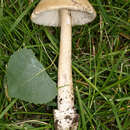en
names in breadcrumbs


The obvious staining reaction, the very weak structure of the NON-graying volval sac, the association with Populus, and microscopic details.
Known distribution from Michigan to Kansas and Nebraska to Colorado, Wyoming, Idaho, and New Mexico in the U.S.A. Not uncommon in rest stops on routes I-70 and I-80 when Cottonwood is present. Look in stream beds and bottom lands where Cottonwood is present, in the high plains states of the U.S.A.
A white to pallid member of Amanita sect. Vaginatae. All parts of the fruiting body take on a more or less pale rusty orange tint as it matures. The volval breaks up into placques and is very loosely attached to the stipe base. Excavation is required to recover volval remnants.
Associated (so far as is known) only with the genus Populus (Aspens and Cottonwoods)
In N. America, this species appears to be unique. However, an inexperienced collector could potentially confuse this species with other Amanita species some of which are deadly poisonous.
This taxon was eaten by the Moses family. Elizabeth Moses reported that the stems were “pleasantly crispy.” However, note that this does not absolutely confirm it’s general edibility and some expert mycologists warn against eating any __Amanita__s.